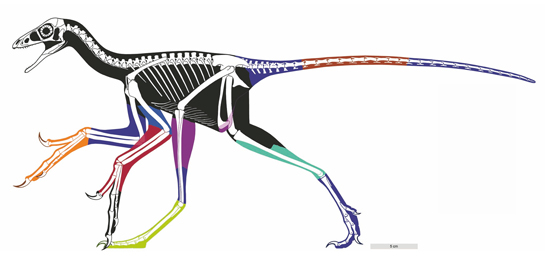A new species of Early Jurassic plesiosaur has been named based on a detailed examination of an almost complete fossil specimen discovered nearly fifty years ago. The articulated specimen represents a skeletally immature individual, and it has been named Plesionectes longicollum. Writing in the open-access journal PeerJ, the researchers identified several unique anatomical features of the fossil that permitted the erection of a new taxon. For instance, this plesiosaur had an exceptionally long neck. At least forty-three cervical vertebrae have been identified. The count hampered by the poor state of preservation of the skull.
The fossil material had been studied previously. For example, evidence of soft tissue preservation had been identified on the neck, tail and rear limbs. In addition, V-shaped neurocentral sutures have been identified. Furthermore, this animal had between twenty and twenty-one dorsal vertebrae, one of the highest counts known among Lower Jurassic plesiosaurs.
Moreover, the fossil was excavated from a different horizon from the famous oil shales exposed near to Holzmaden. It is much older than other plesiosaurs known from the Posidonia Shale (Posidonienschiefer Formation). The remains of this marine reptile are thought to be around 183 million years old.
Picture credit: Peter Nickolaus
Plesionectes longicollum
Researcher Sven Sachs (Naturkunde-Museum Bielefeld, Germany) in collaboration with his colleague Daniel Madzia from the Polish Academy of Sciences, conducted the first detailed osteological examination of the fossil material. This fossil is surprisingly large compared to other plesiosaurs known from the Posidonia Shale. It measures approximately 2.95 metres long, but when the head is included, this marine reptile would have measured around 3.2 metres in length.
The genus name derives from the Greek for “close” or “near”, referring to its plesiosaur affinities, and the Greek word for “swimmer” a common suffix in plesiosaur taxon nomenclature. The species name derives from the Latin and means “long neck”.
To read a recent blog post about examination of soft tissue preservation in a plesiosaur from the Posidonia Shale: Lower Jurassic Plesiosaur Soft Tissue is Examined.

The Plesionectes longicollum holotype (SMNS 51945). Patches of soft tissue have been preserved around the neck, tail, and hindlimb. This marine reptile is thought to have measured around 3.2 metres in length. Picture credit: Sven Sachs.
Picture credit: Sven Sachs
Discovered in 1978
The fossil material was found in 1978. It was discovered by Gotthilf Fischer in his own quarry in Holzmaden. The specimen was prepared by its discoverer and in 1979 it was acquired by the Staatliches Museum für Naturkunde (Stuttgart).
In personal correspondence with Everything Dinosaur, researcher Sven Sachs outlined the direction of his future studies. He intends to commence a reassessment of the famous genus Plesiosaurus.
Sven commented:
“It will surely take a few years to visit all the collections where Plesiosaurus material is housed, to analyse the data, and to write it all up, but this will be a fun project as it is such an iconic taxon.”

A close view of the posterior cervical vertebrae of Plesionectes longicollum. This early-diverging plesiosauroid from the Lower Jurassic Posidonia Shale of Holzmaden, Germany had at least 43 neck bones. Picture credit: Sven Sachs.
Picture credit: Sven Sachs
In summary, this newly described species helps to define the remarkable diversity of Lower Jurassic plesiosauroids known from Germany. In addition, it invites renewed examination of specimens in museum collections.
Everything Dinosaur acknowledges the assistance of one of the study’s authors in the compilation of this article.
The scientific paper: “An unusual early-diverging plesiosauroid from the Lower Jurassic Posidonia Shale of Holzmaden, Germany” by Sven Sachs and Daniel Madzia published in PeerJ.





Leave A Comment